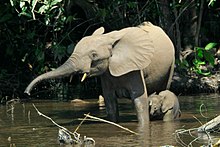Mbeli Bai
This article includes a list of references, related reading, or external links, but its sources remain unclear because it lacks inline citations. (January 2012) |


Mbeli Bai is a 13 hectare swampy forest clearing in the Nouabalé-Ndoki National Park in the Republic of Congo with minimum levels of disturbance, where “bai’s” like this are believed to offer important nutritional benefits to many species.
Since the end of the 1990s the Wildlife Conservation Society has worked in the north of the Republic of Congo and in 1993 together with the Ministry of Forest Economy and Environment has created the Nouabalé-Ndoki National Park (4,200 km²). The Nouabalé-Ndoki National Park with its low levels of disturbance represents one of the last remaining intact forest blocs (no history of logging) in the Congo Basin and an important stronghold for western gorillas, forest elephants and other endangered forest mammals.
Researchers have been continuously monitoring the mammals visiting Mbeli Bai since February 1995 with the aim to increase our understanding of the biology of western gorillas and other large mammals that are otherwise difficult to study in the dense rain forest. Since 1995 more than 330 gorillas have been monitored (actual population ~130 gorillas) spanning more than 1750 gorilla years of around 55 gorilla units (groups and solitary silverbacks). The result of this monitoring of individual identifiable animals has provided major and unique insights into the social organization and behavior of this elusive species including many spectacular behavioral observations such as twin births, silverback splash displays and the first observation of tool use in free-ranging gorillas[3][4] findings that have attracted significant international media attention.
References
- ^ "Wild Gorillas Handy with a Stick". PLoS Biology. 3 (11): e385. 2005. doi:10.1371/journal.pbio.0030385.
{{cite journal}}: CS1 maint: unflagged free DOI (link) - ^ Gross, L. (2007). "In the Shadows of the Congo Basin Forest, Elephants Fall to the Illegal Ivory Trade". PLoS Biology. 5 (4): e115. doi:10.1371/journal.pbio.0050115. PMC 1845160. PMID 20076667.
{{cite journal}}: CS1 maint: unflagged free DOI (link) - ^ Parnell, R. J.; Buchanan-Smith, H. M. (2001). "Animal behaviour. An unusual social display by gorillas". Nature. 412 (6844): 294. doi:10.1038/35085631. PMID 11460152.
- ^ Breuer, T.; Ndoundou-Hockemba, M.; Fishlock, V. (2005). "First Observation of Tool Use in Wild Gorillas". PLoS Biology. 3 (11): e380. doi:10.1371/journal.pbio.0030380. PMC 1236726. PMID 16187795.
{{cite journal}}: CS1 maint: unflagged free DOI (link)
